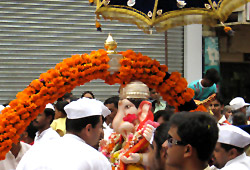 It is the second Ganapati honoured to the place, was one of the early-established Ganesh Mandals. The mandal has already completed 100 years. The idols resemble elephants.
It is the second Ganapati honoured to the place, was one of the early-established Ganesh Mandals. The mandal has already completed 100 years. The idols resemble elephants.
The Jogeshwari or Yogeshwari as described in `Bhavishyapurana` is a combination of `Jeeva` (life) and `Ishwar` (God). Yogeshwari that is red (`Tambadi` in Marathi) is called a Tambadi Jogeshwari. As stated in Purana, the one who destroyed `Tamrasura` is Tambadi Jogeshwari. Jogeshwari is Pune`s Gramdaivata (one who saves the town from evils). She plundered the evils in the boundary of the town itself and never allowed them to enter the town`s vicinity.
At that time there was no temple; the murthi (idol) is `swayambhu` (came out of its own origin). Jogeshwari was the `Kuldaivata` (the Almighty who guards the family from any evil doings) of the Peshwas and Shivaji Maharaj. Many Puneites still pray to her at the beginning of any hard or good work. The Bendres, a historically brave family has been performing the puja for the last 300 or more years.





















